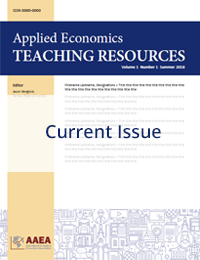Research Article
An Authentic Learning Approach to Group Assignments: An Analysis of Student Attitudes
Roger Brown(a), Na Zuo(b), Jordan Shockley(a), and Steven Buck(a)
(a)University of Kentucky
(b)University of Arizona
JEL Codes: A22, A23, M12, Q00
Keywords: Authentic learning, students, teaching, teamwork
First Published Online: December 10, 2019
Volume 1, Issue 2
Abstract
Using a difference-in-difference estimator adapted to include student fixed effects, we examine whether exposure to an authentic, business-oriented approach to group assignments improves student attitudes about working in groups. Our results show that, compared with a traditional approach, students exposed to the business-oriented approach had significantly improved attitudes about group assignments in general. Specifically, students indicate that forming groups was more authentic and likable, individual grading processes were fairer, and scheduling group meetings was easier. We also identify the marginal effects for these improved attitudes and show that the relevant factors are, in descending order of importance, improvements to group scheduling, group formation, and individual grading.
References
Athey, S., and G.W. Imbens. 2006. “Identification and Inference in Nonlinear Differenceâ€inâ€Differences Models.” Econometrica 74(2):431–497.
Beckwith, A.L., D.R. Carter, and T. Peters. 2016. “The Underrepresentation of African American Women in Executive Leadership: What’s Getting in the Way?” Journal of Business Studies Quarterly 7(4):115–134.
Brescoll, V.L. 2015. “Leading with Their Hearts? How Gender Stereotypes of Emotion Lead to Biased Evaluations of Female Leaders.” The Leadership Quarterly 27(3):415–428.
Brown, R., N. Zuo, J. Shockley, and S. Buck. 2019. “The Project Manager / Private Contractor Approach to Group Assignments.” Applied Economics Teaching Resources 1(2): Forthcoming.
Buckenmyer, J.A. 2000. “Using Teams for Class Activities: Making Course/Classroom Teams Work.” Journal of Education for Business 76(2):98–107.
Carnes, A., J.D. Houghton, and C.N. Ellison. 2015. “What Matters Most in Leader Selection? The Role of Personality and Implicit Leadership Theories.” Leadership & Organization Development Journal 36(4):360–379.
Caspersz, D., M. Wu, and J. Skene. 2003. “Factors Influencing Effective Performance of University Student Teams.” Research and
Development in Higher Education 26 (Proceedings HERDSA). Christchurch, New Zealand.
Chapman, K.J., M. Meuter, D. Toy, and L. Wright. 2006. “Can’t We Pick Our Own Groups? The Influence of Group Selection Method on Group Dynamics and Outcomes.” Journal of Management Education 30(4):557–569.
Felder, R.M., and R. Brent. 2001. “Effective Strategies for Cooperative Learning.” Journal of Cooperation and Collaboration in College Teaching 10(2):69–75.
Fleischmann, K., and R.J. Daniel. 2010. “Increasing Authenticity through Multidisciplinary Collaboration in Real-Life Scenarios in Digital Media Design Education.” CoDesign 6(2):61–74.
Gottschall, H., and M. Garcia-Bayonas. 2008. “Student Attitudes Towards Group Work Among Undergraduates in Business Administration, Education and Mathematics.” Educational Research Quarterly 32(1):3–28.
Greene, W. 2012. Econometric Analysis, 7th ed. New York: Pearson.
Hansen, R.S. 2006. “Benefits and Problems with Student Teams: Suggestions for Improving Team Projects.” Journal of Education for Business 82(1):11–19.
Herrington, J., and R. Oliver. 2000. “An Instructional Design Framework for Authentic Learning Environments.” Educational Technology Research and Development 48(3):23–48.
Herrington, J., T.C. Reeves, and R. Oliver. 2010. A Guide to Authentic e-Learning. New York: Routledge.
Hill, L.G., and D.L. Betz. 2005. “Revising the Retrospective Pretest.” American Journal of Evaluation 26(4):501–517.
Karacaâ€Mandic, P., E.C. Norton, and B. Dowd. 2012. “Interaction Terms in Nonlinear Models.” Health Services Research 47(1):255–274.
Kaufman, D.B., and R.M. Felder. 2000. “Accounting for Individual Effort in Cooperative Learning Teams.” Journal of Engineering Education 9(2):133–140.
King, M.A., and H.F. Sweitzer. 2014. “Towards a Pedagogy of Internships.” Journal of Applied Learning in Higher Education 6:37–59.
Macdonald, H., J.D. Zinth, and S. Pompelia. 2019. 50-State Comparison: High School Graduation Requirements. Denver CO: Education Commission of the States.
McCarthy, P.R., and H.M. McCarthy. 2006. “When Case Studies Are Not Enough: Integrating Experiential Learning into Business Curricula.” Journal of Education for Business 81(4):201–204.
National Association of Colleges and Employers (NACE). 2017. Job Outlook 2018. Bethlehem PA: NACE.
Norton, E.C., H. Wang, and C. Ai. 2004. “Computing Interaction Effects and Standard Errors in Logit and Probit Models.” Stata Journal 4:154–167.Page | 13 Volume 1, Issue 2, December 2019
Oakley, B., R.M. Felder, R. Brent, and I. Elhajj. 2004. “Turning Student Groups into Effective Teams.” Journal of Student Centered Learning 2(1):9–34.
Pfaff, E., and P. Huddleston. 2003. “Does It Matter if I Hate Teamwork? What Impacts Student Attitudes toward Teamwork.” Journal of Marketing Education 25(1):37–45.
Phipps, M., C. Phipps, S. Kask, and S. Higgins. 2001. “University Students’ Perceptions of Cooperative Learning: Implications for Administrators and Instructors.” The Journal of Experiential Education 24(1):14–21.
Puhani, P.A. 2012. “The Treatment Effect, the Cross Difference, and the Interaction Term in Nonlinear ‘Difference-in-Differences’ Models.” Economics Letters 115(1):85–87.
Skeff, K.M., G.A. Stratos, and M.R. Bergen. 1992. “Evaluation of a Medical Faculty Development Program: A Comparison of Traditional Pre/Post and Retrospective Pre/Post Self-Assessment Ratings.” Evaluation & the Health Professions 15(3):350–366.
Weldy, T.G., and D.L. Turnipseed. 2010. “Assessing and Improving Learning in Business Schools: Direct and Indirect Measures of Learning.” Journal of Education for Business 85(5):268–273.
Articles in this issue
Outstanding Seniors: Where Have All the Young Men Gone?
Paul Wilson and Na Zuo
Valuing College Graduate Attributes and Skills: Employer Willingness to Pay as Elicited through Design Valuation
Ryan Feuz and F. Bailey Norwood
An Authentic Learning Approach to Group Assignments: An Analysis of Student Attitudes
Roger Brown, Na Zuo, Jordan Shockley, and Steven Buck
Teaching Competition Topics: Applications of Seller Market Power in Agricultural Industries
Yuliya V. Bolotova
The Project Manager / Private Contractor Approach to Group Assignments
Roger Brown, Na Zuo, Jordan Shockley, and Steven Buck


